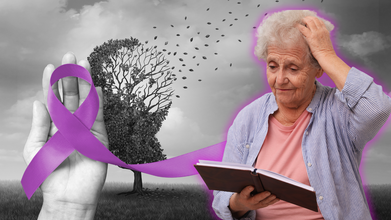- Health Conditions A-Z
- Health & Wellness
- Nutrition
- Fitness
- Health News
- Ayurveda
- Videos
- Medicine A-Z
- Parenting
World Mental Health Day 2025: Mild Memory Loss or Alzheimer’s? A Deeper Look at Both Conditions

(Credit-Canva)
Alzheimer’s disease is no longer a distant concern for India. The Dementia India Report projects that the number of people living with dementia will rise from 8.8 million in 2019 to nearly 14 million by 2036. Alzheimer’s, which accounts for 60–70% of these cases, represents the single largest contributor. This sharp increase is driven by longer life expectancy, urbanization, and lifestyle-related risk factors. For clinicians, the challenge is not only in managing the disease, but also in addressing the widespread confusion between what is described as “mild memory loss” and what is in fact the onset of Alzheimer’s.
Normal Ageing vs. Alzheimer’s Onset: What's The Difference?
Mild forgetfulness is common in ageing. Occasional lapses such as misplacing objects or briefly struggling to recall names are typically recognized by the individual and do not affect independence. In medical terms, this is often classified as age-associated memory impairment. It does not progress in a predictable manner, nor does it consistently interfere with daily living.
Also Read: Kevin Jonas’ Wife Danielle Shares The Hidden Sign That Led To Her Lyme Disease Diagnosis
Alzheimer’s, by contrast, is a progressive neurodegenerative disorder. The initial manifestations may also involve forgetfulness, but the difference lies in persistence, pattern, and impact. Patients begin to forget recent events repeatedly, lose their way in familiar settings, and struggle with language and judgment. Over time, the ability to manage personal, financial, and social responsibilities declines. Unlike benign memory lapses, these deficits are noticed more by caregivers than by the individual, and they steadily worsen.
Why Is It Difficult To Diagnose Mild Cognitive Impairment
The diagnostic overlap is further complicated by the intermediate state of Mild Cognitive Impairment (MCI). Epidemiological studies indicate that 10–15% of individuals with MCI convert to Alzheimer’s annually. Yet not all do some remain stable, and a minority even improve. This uncertainty often leads to misdiagnosis in both directions: dismissing early Alzheimer’s as “normal ageing,” or labelling harmless forgetfulness as dementia. Both outcomes are problematic, the former delaying intervention and the latter generating unnecessary stigma.
Accurate differentiation requires structured evaluation. Clinical history, neurological examination, cognitive testing, and, where appropriate, neuroimaging or biomarker analysis form the basis of assessment. The aim is early identification, because therapeutic benefit is greater when intervention begins before significant decline has occurred.
Also Read: RFK Jr. Claims Tylenol After Circumcision May Be Linked to Autism
What Is The Best Way To Treat Cognitive Decline?
Preventive strategies must be emphasized in parallel. Cohort studies from India and abroad show that up to 40% of dementia risk can be attributed to modifiable factors. Hypertension, diabetes, obesity, smoking, physical inactivity, social isolation, and hearing loss are prominent among them. Addressing these through regular medical care, physical exercise, mental stimulation, and social engagement can reduce incidence and delay onset. Public health efforts in India must therefore move beyond treatment to encompass risk reduction at a community level.
As Alzheimer’s Awareness Month reminds us, memory complaints in older adults are not uniform. Some reflect the natural ageing of the brain; others signal a disease process that will progressively erode autonomy and quality of life. For physicians, families, and policymakers alike, the responsibility lies in recognizing the difference. Precision in diagnosis, combined with preventive care, remains our best opportunity to mitigate the growing impact of Alzheimer’s disease in India.
Is Santa Claus Bad for Your Health? Here’s Why a Doctor Is Raising Concerns Ahead of Christmas

Credits: iStock
Santa Claus is bad for your health! This is a statement by Dr Nathan Grills, a Public Health Fellow in the Department of Epidemiology and Preventative Medicine, Monash University, Australia. Why is he saying this right ahead of Christmas?
Writing for an article in the British Medical Journal's Christmas issue (BMJ), he says, "Santa only needs to affect health by 0.1% to damage million of lives". He says it would be better if his popularity was rather used to promote healthy living.
Why Is Santa Claus Unhealthy?
Santa Claus's portrayal is where the concerns lie. This was not the first time someone has talked about. In fact, The Conversation in December 2024, talked about this exactly. If you look at Santa, he stands anywhere between 5'6" to 6'6" and weighs between 80Kgs to 136Kgs. He also carries a lot of weight around his belly, which, some may say, keeps him insulated as he sleighs through the snowy lands, but is sure overweight and obese. These portrayal promotes an unhealthy living.
Dr Grils also writes that Santa should rather share Rudolf's snack of carrots and celery sticks than brandy and mince pies, and swap his reindeer for a bike or a walk.
After reviewing existing literature and online sources to understand Santa Claus’s possible impact on public health, the analysis found no peer-reviewed studies directly addressing the issue. What did stand out, however, was the exceptionally high level of awareness of Santa among children. In fact, surveys of American schoolchildren showed that Santa Claus was recognized more widely than almost any other fictional character, second only to Ronald McDonald.
The doctor says that Santa is also used for selling products, which are mostly harmful, and this happens on global scale, which means, people get inspired. "Santa sells, and sometimes he sells harmful products. Like Coca-Cola, Santa has become a major export item to the developing world."
While Santa has been banned from smoking, but his images of enjoying a pipe or cigar are easily found on Christmas cards. The depiction of Santa does form a public perception, argues the doctor.
Dr Grill also notes that Santa may be promoting potential drink-driving, especially when someone follows the tradition to leave him a brandy to wish him well on his travels, while he has billion houses to visit.
Can Santa Spread Diseases?

Dr Grill says that he can spread diseases. If Santa sneezes or coughs around 10 times a day, all the children who sit on his lap may also end up catching the flu along with their Christmas presents.

However, it is important to note that these are views expressed by the doctor and no actual studies have been conducted on the same, Though Dr Grill does indicate for more research before calling for authorities to regulate Santa's activities. For now, Dr Grill proposes a new image for Santa, a healthier one. A slim Santa on a treadmill.
Did You Know The Role Appendix Plays In Your Body? It Is More Important Than You Think

Credits: iStock
For years, the appendix was brushed off as a useless leftover from human evolution. Many of us grew up believing that it served no real purpose and was better off removed at the first sign of trouble. But science now tells a more interesting story. This small, finger-like pouch attached to the large intestine quietly supports gut health and immunity in ways that were long overlooked.
What exactly is the appendix?
The appendix is a narrow tube connected to the cecum, located in the lower right side of the abdomen. It usually measures between 7 and 10 cm, although its size and position can vary widely from person to person. In some people, it may be just a couple of centimeters long, while in others, it can extend much further. This variation is also why appendicitis pain can sometimes feel confusing or atypical.
Not useless after all
The biggest shift in understanding the appendix came from research into gut bacteria. The appendix appears to act as a safe storage space for beneficial microbes. During bouts of severe diarrhea or intestinal infections, large amounts of gut bacteria are flushed out. The appendix helps reintroduce these good bacteria once the illness passes, helping the digestive system recover faster.
It also plays a role in immunity, especially during early life. The appendix contains lymphoid tissue, which exposes immune cells to substances passing through the gut. This helps the body learn how to respond to harmful invaders while tolerating harmless ones. While humans can survive perfectly well without an appendix, its presence offers subtle support to the immune and digestive systems.
Why appendicitis happens
Despite its benefits, the appendix is still prone to inflammation. Appendicitis is one of the most common abdominal emergencies worldwide. It usually occurs when the appendix gets blocked, often due to hardened stool, infection, or rarely, abnormal growths. Once blocked, bacteria multiply, causing swelling, pain, and infection.
The classic warning sign is pain that starts near the belly button and gradually shifts to the lower right abdomen. This may be accompanied by fever, nausea, vomiting, and loss of appetite. Ignoring these symptoms can be dangerous. If left untreated, the appendix can rupture, leading to serious and potentially life-threatening complications.
Busting Common Myths
There are many myths surrounding the appendix. One of the most common is that fruit seeds or spicy food cause appendicitis. There is no evidence to support this. Another misconception is that appendicitis can settle on its own. While pain may temporarily reduce, the underlying inflammation usually worsens.
Many people also worry that removing the appendix will harm digestion or require lifelong dietary restrictions. In reality, most people return to normal eating habits and daily routines after recovery, with no long-term health issues.
How appendicitis is treated
Surgery remains the most reliable treatment for appendicitis. Today, minimally invasive techniques such as laparoscopic or robotic surgery are widely used. These involve small incisions, less pain, quicker recovery, and shorter hospital stays. In complicated cases, open surgery may still be required.
In selected cases of mild, uncomplicated appendicitis, antibiotics may be used initially. However, studies show that while symptoms may improve, there is a higher chance of recurrence within months. For this reason, surgery continues to be the definitive, long-term solution for most patients.
Recovery after appendix removal is usually smooth. Many patients are able to walk the same day and return home within a day or two. Light meals are recommended initially, and heavy lifting is avoided for a few weeks. Long-term lifestyle changes are rarely needed, and most people forget about the surgery entirely once healed.
Delhi AQI Stays ‘Very Poor’ As CM Rekha Gupta Holds Review Meet For Pollution

Credits: iStock
Delhi's air quality remained in "very poor" category, and the AQI stood at 342 at 8am, as per the Central Pollution Control Board. The 24-hour average AQI was logged at 412 under the "severe" category on Tuesday evening when Delhi's quality peaked to record the fourth severe air day in the month of December. With the air quality levels remaining continuously in the "very poor" category, Delhi's Chief Minister Rekha Gupta held a pollution review meet.
What Was Discussed In The Pollution Review Meet By Rekha Gupta?
A review meeting was held to discuss the rising air pollution levels in Delhi on Monday at the Delhi Secretariat. The meeting was attended by the officials from various departments, which also included the Public Works Department (PWD), Transport, Delhi Pollution Control Committee (DPCC), Environment, and others.
Post meeting, Delhi Environment Minister Manjinder Singh Sirsa said that the CM sought responses from multiple departments to discuss various aspects of pollution in the national capital. Sirsa also confirmed that a follow-up meeting will be scheduled on Thursday to continue the discussions on various steps that should be taken to bring down the levels of Delhi's AQI.
Rely On Public Transport - As A Solution To Delhi Pollution
On Sunday, a day before the meeting was held, Delhi's CM spoke on relying on public transport as a solution to Delhi's pollution. She said that the government aims to make the metro network "so comprehensive that people do not need to rely on private vehicles even for last-mile connectivity”.
Delhi's Pollution Is Now A Public Health Risk
An analysis by the Global Burden of Disease (GBD) 2023 found that air pollution is city's single largest health risk. The deaths rose from 15,786 in 2018 to 17,188 in 2023.
Another study published in Scientific Reports, a five-year study titled Respiratory Deposition of Particulate Matter in Delhi: A Five-Year Assessment of Exposure Patterns and Health Risks tracked how particulate matter settles inside the respiratory system and found that men's exposure can be up to 1.4 times higher, especially while walking or commuting. The study noted that men on average spend more time outdoors while working, commuting, or walking in traffic-heavy areas. This leads to an increase in exposure.
A different study published in Frontiers in Public Health, explored the data of 2,96,078 women and girls between the age of 16 to 55 years in Taiwan and correlated it with the long-term air pollution data between 2000 and 2013. None of these women had any history of dysmenorrhea before the survey had began.
Read: Is Delhi's Toxic Air Making Your Period Cramps More Painful? Here's What Study Says
Furthermore, a study published in Nature Communication notes that after four hours of exposure to particulate matter, it was found that people's ability to perform routine tasks and interpret emotions were highly impacted.
If Delhi is able to cut its local pollution by 50 per cent, the pollution too could drop by 50 per cent. The emission should happen across the airshed. However, the focus should be for a long-term action on the source of emission and not short-term optics like cloud seeding, smog towers, water sprinkling or air purifiers.
In fact, as per a study published in Sustainability (MDPI), an open access journal, which mapped Delhi's air quality between 1990 to 2022 and found that transports emit around 10 to 30% of pollution, whereas agricultural residue burning, which is a seasonal source of pollution leads to less than 3% of pollution, whereas firecrackers, another seasonal source, leads to less than 1% of pollution.
© 2024 Bennett, Coleman & Company Limited

